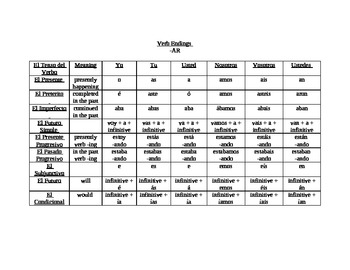


(My mother is coming for a visit tomorrow.) How is the present simple formed in Spanish? (The children go to school at 8 am.)įuture actions: Mañana viene mi madre de visita. Routines: Los niños van al colegio a las ocho. Habitual actions: Yo trabajo en una tienda. It can be used for a lot of different language functions: The present simple tense is one of the most basic and commonly used tenses in Spanish. So, without further ado, let’s take a closer look at the 4 most used tenses in Spanish, how they are used and when to use them… Present Simple This means that once you’ve learned the basics of conjugation patterns in Spanish, you’re well on your way to mastering the verb tenses!

Spanish verb endings for mi amigos trial#
→Sign Up Now: Free Trial Spanish Lesson With a Native Teacher!←įor example, the number of irregular verbs in Spanish is relatively small compared to English. But once you’ve mastered the basics, you will see that verb tenses in Spanish are actually quite straightforward – and even simpler than their English counterparts in some ways! If you’re just starting to learn the language, then yes, there are certainly some tricky grammar rules to get your head around. Well, that all depends on your level of Spanish. But, is Spanish grammar all that difficult? The verb sentir (to feel, to regret) is a stem changer in the present tense, but Table 7 will remind you that no verbs stem change in the imperfect tense.As a Spanish teacher, I’ve noticed that as soon as you write “Verb Tenses in Spanish” on the board, English speakers start shivering. The – er verbs use the exact same endings in the imperfect tense as the – ir verbs, so look at perder as another good example and notice in Table 5 that perder does not stem change in the imperfect tense.Ī regular verb like vivir (to live) conjugated in Table 6 serves as a good example of an – ir verb in the imperfect tense. Notice that all imperfect tense forms of – er and – ir verbs have a written accent mark on the letter i. For every other – er and – ir verb, use the endings in Table 4. There are only three irregular verbs in the imperfect tense: ser, ir, and ver. The endings in Table 4 are the regular endings for both – er and – ir verbs. Read Table 3 outloud because it's fun to say the imperfect tense forms of the verb trabajar. The verb trabajar (to work) looks really strange in the imperfect tense, but it also is a good example that all forms of all – ar verbs are regular in the imperfect tense. As you can see in Table 2, the verb pensar is completely regular in the imperfect tense. Also notice that only the nosotros/nosotras form has a written accent mark.Ī stem‐changing verb like pensar (to think) will not have any stem change in the imperfect. Notice that the yo form is exactly like the él, ella, and usted forms, so it is important to use the pronoun or noun to specify what the subject is in a specific sentence. There is not a single – ar verb that is irregular in the imperfect tense. The – ar endings found in Table 1 are used for every – ar verb in the entire language. There are no spelling changes and no stem changes in the imperfect. Usually, the imperfect tense is translated as “was / were doing” something, or “used to do” something.
Spanish verb endings for mi amigos how to#
While it is easy to learn how to create the forms of verbs in the imperfect tense, it is more difficult to understand when to use this tense. Only three verbs in the entire language are irregular in the imperfect tense. The imperfect tense is another past tense aspect in Spanish. Quiz: Command Forms with Reflexive Pronouns.Reflexive, Prepositional, and Demonstrative Pronouns.Verbs That Change Meaning in the Preterite.Quiz: Verbs That Change Meaning in the Preterite.Quiz: Irregulars in the Preterite Tense.Quiz: Stem Changers in the Preterite Tense.Quiz: Different Yo Forms in the Preterite Tense.Different Yo Forms in the Preterite Tense.Quiz: Regular Verbs in the Preterite Tense.Quiz Indirect Objects and Indirect Object Pronouns.Indirect Objects and Indirect Object Pronouns.Quiz: Direct Objects and Direct Object Pronouns.Direct Objects and Direct Object Pronouns.Quiz: Using the Right Pronoun to Answer a Question.Using the Right Pronoun to Answer a Question.Quiz: Interrogative Pronouns (Question Words).Interrogative Pronouns (Question Words).Stem-Changing Verbs in the Present Tense.Quiz: Common Verbs Irregular in the Present Tense.Common Verbs Irregular in the Present Tense.Quiz: Confusing Verbs: Determining which Verb to Use.Confusing Verbs: Determining Which Verb to Use.Quiz: Stem-Changing Verbs in the Present Tense.Quiz: Regular Verbs in the Present Tense.


 0 kommentar(er)
0 kommentar(er)
